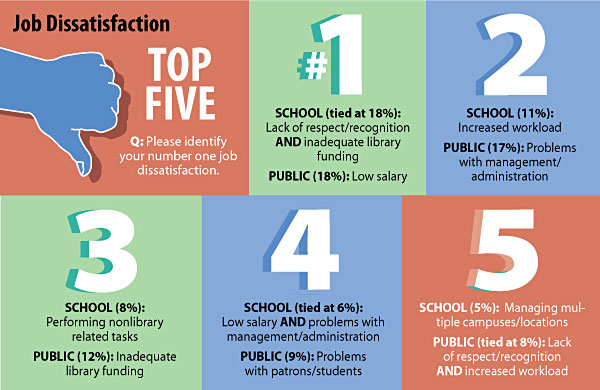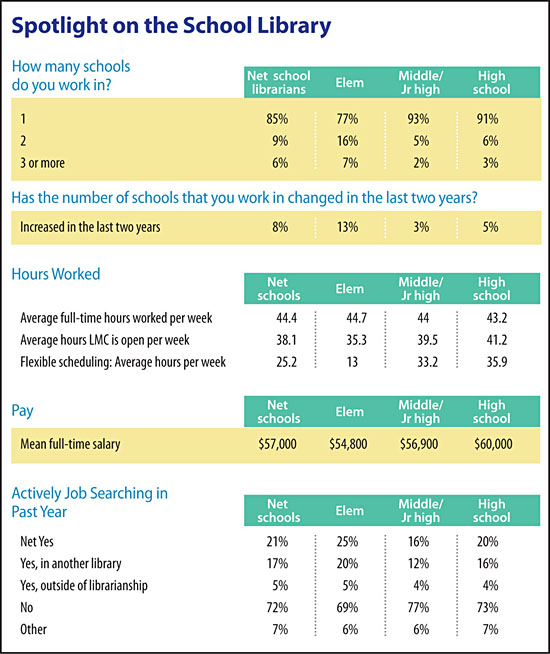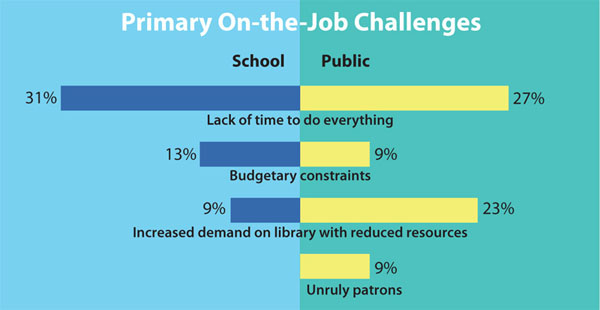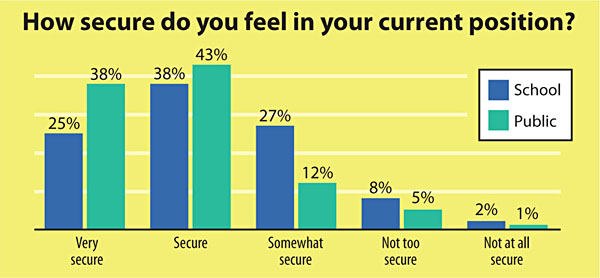SLJ’s 2013 Job Satisfaction Survey | What’s Not to Love?

Chart Designs by Mark Tuchman.
Igniting a love for reading is primarily what drives job satisfaction for librarians who work with teens. And satisfied they are—seven out of ten school media specialists and public librarians working directly with children and/or teens report they are either satisfied or very satisfied with their jobs. SLJ set out to learn more about the motivations and challenges in the profession in a recent national job satisfaction survey of just over 1,000 school and public librarians.
We asked librarians to identify the many rewards of their jobs and to pinpoint their top-most satisfaction. Connecting young people to reading and lifelong learning was by far their single biggest gratification. “I love when I am able to find a book for a student who is resisting reading, and that book changes their outlook on reading,” says Carrie Kausch, school librarian for Osbourn Park High School in Manassas, Virginia.
“There is very little that gives me as much satisfaction as hearing a student say, ‘I loved that book! What else can I read?’” adds Melanie Gibson, a private school librarian in Dallas, Texas. Clearly there is a lot of passion for the work at hand. Service is the priority, not prestige or income, when working in the library. “I love the meaningful investment I get to make on a daily basis in the lives of young people,” writes a high school librarian from rural Tennessee.
Another high school teacher-librarian from suburban Illinois gushes, “This job is a dream. I get to buy books, plan projects collaboratively, teach [technology] skills, talk to students about books, and throw parties for students in the form of library programs.”

The library is a program, not a room
While the rewards for the job are many, there are also some drawbacks. Public librarians are more likely than their school counterparts to identify them as low salary and problems with management, coworkers, or even library users. On the flip side, lack of respect and recognition, inadequate library funding, and the expectation to perform nonlibrary-related tasks are especially irksome for school librarians.
School librarians feel less appreciated by those who hold the purse strings than do public librarians. Fewer than half feel they get the recognition or respect they deserve from their superintendent or school board. “It is a constant uphill fight for administration to understand, acknowledge, and support collaboration and information-fluency skills, and to get them to understand that the library is a program, not a room,” laments Stephanie Rosalia, a teacher-librarian in New York City.
Just over half of the public librarians surveyed express confidence that library administrators and local community leaders give them the appropriate respect and recognition.
Challenges to overcome
Regardless of where librarians work, their biggest on-the-job challenge is lack of time to get everything accomplished. “Performing nonlibrarian tasks such as emptying the book drop, shelving books, paging, and other technical tasks keeps me from doing things like outreach, marketing, and promotion of library services to the community,” writes one California public librarian.
Other shared hurdles include ever-present budgetary constraints and increased demand on the library with fewer resources (especially support staff). Managing unruly patrons also figures prominently as one of public librarians’ biggest challenges.
Future challenges anticipated by school librarians include adapting to Bring Your Own Device (BYOD) proposals, meeting the needs brought by the Common Core State Standards initiative, and the ongoing transition to digital resources and tools. Steven Alcorta of California’s Sonoma County Library sums up the challenge for public librarians as, “changing technologies and the expectation that staff will be expert on all of them.”

Professional latecomers
It may be surprising to learn that about three-quarters of school media specialists and half of public librarians working with children chose librarianship as their second, and sometimes third, career. Most of these school media specialists were previously classroom teachers. Some had grown tired of the planning, testing, and grading associated with that profession. They desired more autonomy and the chance to be creative while still meeting education goals. When the library opportunity arose, they went for it.
For some, changing positions within a school resulted in an initial drop in respect from faculty and students alike. “I heard a lot of ‘Oh, you are not a teacher anymore,’” writes one elementary media specialist from suburban Illinois. “After much effort personally and professionally, I have turned our library into an extension of the classroom.”
Many transplanted school librarians acknowledge they had to work hard and grow into the position, but they are not disappointed. In fact, satisfaction levels for school librarians entering the profession later in their careers far exceed first-career librarians—by 15 percentage points. “I am much more suited to the multitasking of librarianship and love [the] connection I make with students and teachers,” a high school media specialist and former classroom teacher from Charleston, South Carolina, reveals.

Salary, security, and advancement
The median annual salary for a full-time children’s or youth services librarian working at a public library is $44,700. This is considerably less than the median school librarian salary of $57,000. School librarians with an MLS degree earn significantly more than those without an MLS (median of $58,400 versus $37,500).
Public librarians feel far more secure in their jobs overall than do school media specialists (82% of public librarians and 63% of school librarians feel either secure or very secure). But, insecurity is not widespread. Only one in ten school librarians reported that their jobs are either not too or not at all secure. There is a strong correlation between respondents feeling job insecurity and having low job satisfaction.
Prospects for advancement are low but tend not to impact satisfaction. About three-quarters of public and school librarians say their advancement opportunities are fair to poor. Despite this outlook, 88% would choose their careers again.
Nearly a third of public librarians and one-fifth of school librarians actively searched for a new job in the previous 12 months. Only a quarter of those looked for a position outside librarianship.
Satisfaction by school type
Librarians teaching at the middle or high school level reported higher satisfaction with their jobs than elementary school media specialists (73% and 72% very satisfied or satisfied, respectively, versus 65% very satisfied or satisfied). This is not necessarily correlated with pay—although secondary school librarians do generally make more. Instead, the data suggests that elementary librarian dissatisfaction is tied to being stretched too thin with little or no support staff.
Nearly one-quarter of media specialists working at the elementary school level divides his or her time between two or more locations (16% work in two locations, 7% work in three or more). Thirteen percent gained responsibility for an additional library within the last two years. This has resulted in more time spent managing/troubleshooting and less time interacting with children.
Working on a fixed schedule, where library media center hours are heavily scheduled and students visit as a class at a set time, is common at the elementary level—and it restricts librarians’ ability to collaborate with faculty, a key component of the job. “I have a full schedule of classes in which I am supposed to supplement what the teachers are doing, but I can’t plan with the teachers,” explains Karen Valentine a school librarian at Pleasant Ridge Elementary in North Carolina. “Their planning period is while the students are with me.”
Just over a quarter (29%) of elementary school librarians report that in the last year they were assigned mundane tasks that squander their expertise, compared to 17% of middle school and 20% of high school librarians. Having to perform duties such as administering tests or minding study halls leave elementary school librarians feeling underappreciated.
Overall, elementary school librarians are less likely than their secondary school counterparts to believe they get the recognition they deserve from classroom teachers and feel less secure in their jobs. Twenty-five percent have searched for a new job in the last year, as opposed to 20% of high school and 16% of middle school librarians.


Drive to be flexible and diverse
Carrie Cline, library director for McDonald County Library in rural Missouri, has some guidance to offer those entering the profession. “It’s nothing like you hear in college! You have to get along with parents, learn to entertain the children, even the ones who are misbehaving, and you can’t take yourself too seriously!” she urges.
The advice applies to librarians at any stage of their careers. “Be extremely flexible. The job description is a fluid one, and the face of librarianship is changing. You need to be able to change with it,” encourages Jennifer Powers, a teacher-librarian at St. John’s Episcopal School in Dallas.
“The more you can do, the more valuable you are,” adds Maggie Bokelman of Eagle View Middle School in Pennsylvania. “Be willing to be a technology specialist, an instructional coach, a research guide, and a reading motivator. I like the fact that our profession is changing, and that I have the opportunity to come up with new ideas and new ways of doing things. It’s an exciting time to be a librarian.”
Method: A job satisfaction survey invite and reminder were emailed to SLJ Extra Helping newsletter subscribers in October 2012. The survey link was also advertised in Extra Helping. Results are based on the responses of 713 U.S. school librarians and 294 U.S. public librarians working directly with children or teens. The data shown in total was weighted to represent national regional breakdowns obtained from the Institute of Museum and Library Services and National Center for Education Statistics.
 Laura Girmscheid is research manager for School Library Journal and Library Journal.
Laura Girmscheid is research manager for School Library Journal and Library Journal.
RELATED
ALREADY A SUBSCRIBER? LOG IN
We are currently offering this content for free. Sign up now to activate your personal profile, where you can save articles for future viewing









Add Comment :-
Comment Policy:
Comment should not be empty !!!